
Territorial behavior
Birds' territorial behaviors are very diverse, and can be grouped into several different types. In the case of the rock ptarmigan, mating, nest building and searching for food all occur within the established territory, which is maintained throughout the breeding season.
Until recently, it was generally thought that the possession of territory was decided during the spring, when rock ptarmigans group together and the males fight to establish a pecking order; through pecking and chasing, the strongest males are established, and it was assumed that they would secure the territory with the best conditions. However, when the fighting behavior was observed in Murododaira with individuals identifiable by foot rings, it was found that although individuals' strength or weakness is tested, there does not appear to be a linear pecking order.
After grouping together in the spring, males which fail to find a partner and establish a territory are frequently seen to attack other males which have an established territory. Furthermore, regarding the area of the territory, excluding examples of death or the displacement of certain old individuals, almost all pairs seem to keep the same territory from year to year.
Rock ptarmigans' territories in the Tateyama Mountain Range tend to be 2-3ha, and there is a tendency for the territories to shrink as snow melts. Fighting to defend territory is more prominent among males, but females have also been observed to battle fiercely, displaying behaviors such as pecking and charging.
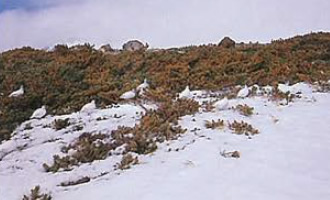
Grouping together in the spring
A large group forms around the limited feeding grounds
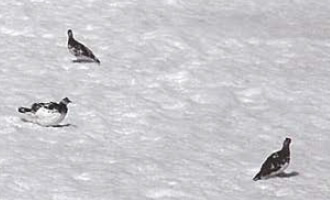
Display behavior among males in the spring
3 individuals check the border between their territories
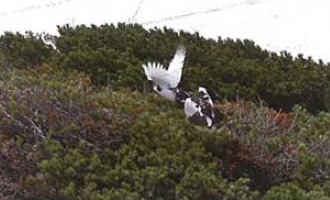
An individual on lookout performs a display flight
In response to an intruder, an individual calls out and takes flight.
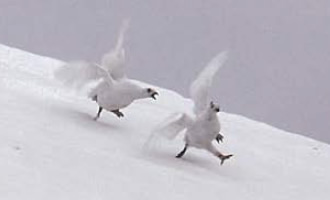
Fighting between females
Fight may not be about territory, but rather about a mate
The male's courting display involves enlarging its comb (a fleshy growth on its head), fanning its tail, dragging its wings along the ground and lowering its head as it approaches the female. The courting display will not necessarily lead to mating. Mating generally occurs in late May or early June, and there do not seem to be any preliminary courting actions necessary beforehand. While it is common for one male to mate with several females in the grouse family, the rock ptarmigan generally forms a monogamous relationship between one male and one female. In Tateyama, there have also been a few cases documented of one male mating with two females.
On the other hand, the males who failed to find a mate are chased out of other males' territories, but they are often seen to sneak back into the area. Sometimes, three or four males are even observed acting as a group. These males will occasionally wait for a chance when the territory male is absent, and then attempt to mate with the female. From observations up to this point, the female simply squats down cowering, and does not receptively shake her feathers as she does with her mate.
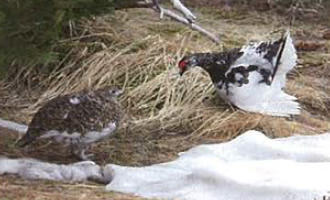
Courting display
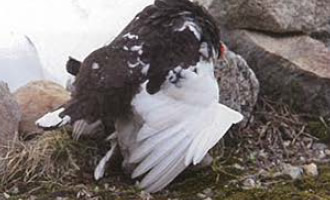
Mating
The male grabs the female's neck with his mouth and climbs on her back. After mating, the male repeats the courting display, and the female puffs up and shakes her feathers.
